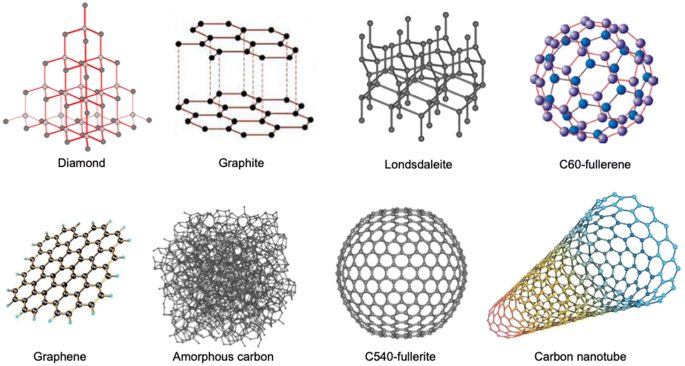Carbon nanotubes are cylindrical structures composed of carbon atoms arranged in a hexagonal lattice. They can be single-walled (SWCNTs) with a single layer of carbon atoms or multi-walled (MWCNTs) with multiple concentric layers. CNTs possess exceptional mechanical, electrical, and thermal properties, making them attractive for a wide range of applications.
Preparation of Carbon Nanotubes:
1. Chemical Vapor Deposition (CVD): CNTs can be grown using CVD by decomposing carbon-containing gases (such as hydrocarbons) at high temperatures in the presence of a catalyst, typically transition metals like iron, cobalt, or nickel.
2. Arc Discharge: This method involves vaporizing a carbon electrode through a high-current electric arc in an inert gas atmosphere. The vaporized carbon condenses and forms carbon nanotubes.
3. Laser Ablation: A pulsed laser vaporizes a carbon target in a high-temperature reactor, and the resulting vapor condenses to form CNTs.
Properties of Carbon Nanotubes:
1. Mechanical Strength: CNTs are exceptionally strong and possess high tensile strength.
2. Electrical Conductivity: CNTs exhibit excellent electrical conductivity, comparable to copper or other metallic materials.
3. Thermal Conductivity: CNTs have high thermal conductivity, outperforming most materials.
4. Aspect Ratio: CNTs have a high aspect ratio (length-to-diameter ratio), making them ideal for reinforcement in composite materials.
Applications of Carbon Nanotubes:
1. Electronics: Carbon nanotubes can be used as nanoscale transistors, interconnects, and sensors.
2. Energy Storage: CNTs are investigated for applications in supercapacitors and lithium-ion batteries.
3. Composite Materials: CNTs can reinforce polymers, metals, and ceramics.
4. Biomedical Applications: CNTs have potential uses in drug delivery systems, biosensors, tissue engineering, and imaging technologies.
Advantages of Carbon Nanotubes:
1. Exceptional Properties: CNTs possess remarkable mechanical, electrical, and thermal properties, making them desirable for various applications that require strength, conductivity, and heat dissipation.
2. Lightweight and High Aspect Ratio: CNTs are lightweight, yet they have high aspect ratios, allowing for the development of lightweight and high-performance materials and devices.
3. Versatility: CNTs can exhibit different properties based on their structure and functionalization, enabling their utilization in diverse applications ranging from electronics to energy storage.
Disadvantages of Carbon Nanotubes:
1. Manufacturing Challenges: The large-scale production of high-quality CNTs at a reasonable cost remains a challenge.
2. Toxicity Concerns: Some studies suggest that certain types of CNTs may pose health risks, especially if inhaled in the form of airborne particles.
3. Cost: CNTs can be expensive to produce, limiting their widespread adoption in certain industries.

মন্তব্যসমূহ
একটি মন্তব্য পোস্ট করুন